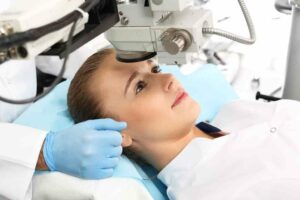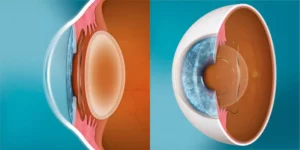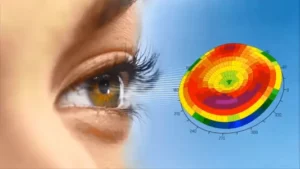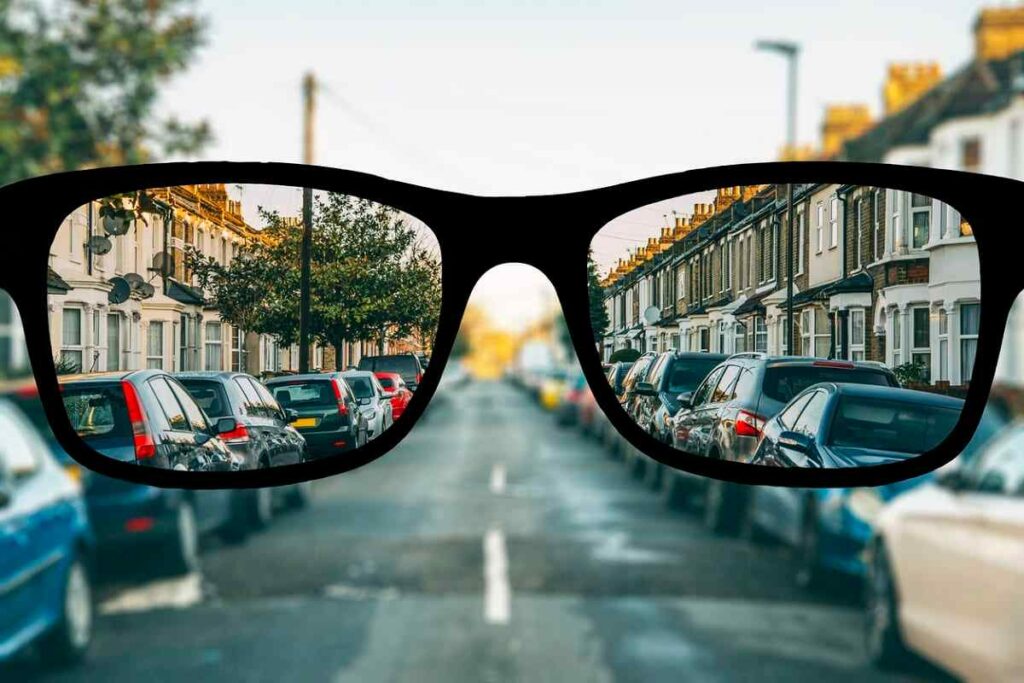If you’re tired of relying on glasses or contact lenses to see clearly, refractive surgery could be the solution you’ve been looking for. In this blog, we will explore different types of refractive surgery and how they can correct myopia. We will also discuss the advantages and recovery process of each type so that you can find the right fit for yourself. Join us as we delve into the world of refractive surgery and discover the potential benefits it holds for improving your vision.
Contents
What Is Myopia?
 Myopia, commonly known as nearsightedness, is a refractive error of the eye that affects the ability to see distant objects clearly. People with myopia can typically see objects up close with clarity, but distant objects appear blurred or blurry. It occurs when the eyeball is slightly longer than normal or when the cornea (the clear front part of the eye) has excessive curvature. Myopia can be corrected with eyeglasses, contact lenses, or refractive surgery.
Myopia, commonly known as nearsightedness, is a refractive error of the eye that affects the ability to see distant objects clearly. People with myopia can typically see objects up close with clarity, but distant objects appear blurred or blurry. It occurs when the eyeball is slightly longer than normal or when the cornea (the clear front part of the eye) has excessive curvature. Myopia can be corrected with eyeglasses, contact lenses, or refractive surgery.
Can A Refractive Surgery Treat Myopia?
Yes, refractive surgery can treat myopia. These procedures may involve inserting a prescription lens inside the eye or treating the cornea. This changes its focusing power, allowing light to be properly focused on the retina and improving distance vision. However, it’s important to consult with an ophthalmologist or refractive surgeon to determine if you are a suitable candidate for refractive surgery based on your specific eye health and individual circumstances.
Types Of Refractive Surgery For Myopia
There are several types of refractive surgeries commonly used to treat myopia (nearsightedness). Here are a few examples:
1. LASIK (Laser-Assisted in Situ Keratomileusis)
LASIK is a popular and widely performed refractive surgery for myopia. The procedure begins by creating a thin, hinged flap on the cornea using a femtosecond laser or a microkeratome (a mechanical blade). The surgeon then lifts the flap, exposing the underlying corneal tissue. An excimer laser is then used to precisely remove a predetermined amount of corneal tissue, reshaping the cornea to correct the refractive error. The excimer laser ablates the tissue with high precision, guided by the individual’s specific prescription. The corneal flap is then repositioned, acting as a natural bandage, allowing for rapid healing and minimal discomfort.
Pros:
- Popular and widely performed.
- Quick recovery time and minimal discomfort.
- Suitable for a wide range of myopia prescriptions.
- Precise corneal reshaping with excellent visual outcomes.
- Potential flap-related complications, such as dry eyes.
2. PRK (Photorefractive Keratectomy)
 PRK is another refractive surgery option for myopia that does not involve creating a corneal flap. Instead, the outer layer of the cornea called the epithelium, is gently removed, exposing the underlying corneal tissue. The excimer laser is then used to reshape the exposed cornea, removing precise amounts of tissue based on the individual’s prescription. Once the cornea is reshaped, a special contact lens or a bandage is placed on the eye to protect the healing cornea. Over time, the epithelium regenerates and covers the treated area. PRK typically has a longer recovery time compared to LASIK as the regrowth of the epithelium takes a few days.
PRK is another refractive surgery option for myopia that does not involve creating a corneal flap. Instead, the outer layer of the cornea called the epithelium, is gently removed, exposing the underlying corneal tissue. The excimer laser is then used to reshape the exposed cornea, removing precise amounts of tissue based on the individual’s prescription. Once the cornea is reshaped, a special contact lens or a bandage is placed on the eye to protect the healing cornea. Over time, the epithelium regenerates and covers the treated area. PRK typically has a longer recovery time compared to LASIK as the regrowth of the epithelium takes a few days.
Pros:
- No corneal flap creation.
- Can be suitable for individuals with thinner corneas.
- No risk of flap-related complications.
- Longer recovery time compared to LASIK.
- Potential for discomfort during the initial healing phase.
3. SMILE (Small Incision Lenticule Extraction)
SMILE is a minimally invasive refractive surgery for myopia that involves creating a small incision in the cornea. Instead of creating a corneal flap or removing the epithelium, a femtosecond laser is used to create a small disc-shaped layer of tissue, known as a lenticular, within the cornea. This lenticule is then removed through the incision, effectively reshaping the cornea and correcting myopia. Since the incision is small, the cornea remains mostly intact, providing greater structural stability. SMILE has gained popularity due to its potential advantages in preserving corneal biomechanics and reducing dry eye symptoms.
Pros:
- Minimally invasive with a small incision.
- Potential advantages in preserving corneal biomechanics.
- Faster visual recovery compared to PRK.
- Suitable for moderate to high myopia.
- Limited availability in certain regions.
4. Implantable Collamer Lenses (ICL)
 ICL is an alternative refractive surgery option for individuals with moderate to high myopia. Unlike the previously mentioned procedures that reshape the cornea, ICL involves implanting a collamer lens, which is a soft and flexible lens, into the eye. The lens is placed between the iris and the natural lens, and it works in conjunction with the eye’s natural lens to focus light properly on the retina. ICLs are designed to be permanently implanted and do not require any regular maintenance. They can be an effective solution for those with thin corneas or higher degrees of myopia.
ICL is an alternative refractive surgery option for individuals with moderate to high myopia. Unlike the previously mentioned procedures that reshape the cornea, ICL involves implanting a collamer lens, which is a soft and flexible lens, into the eye. The lens is placed between the iris and the natural lens, and it works in conjunction with the eye’s natural lens to focus light properly on the retina. ICLs are designed to be permanently implanted and do not require any regular maintenance. They can be an effective solution for those with thin corneas or higher degrees of myopia.
Pros:
- Ideal for individuals with high myopia or thin corneas.
- Reversible procedure; the lens can be removed if necessary.
- Can provide excellent visual quality.
- Requires implantation of an artificial lens.
- Potential risks associated with intraocular surgery.
5. SmartSurf LASIK
SmartSurf LASIK is an advanced variation of LASIK that incorporates advanced surface ablation techniques. It combines the benefits of both LASIK and PRK. The procedure starts with creating a corneal flap similar to LASIK. However, instead of using an excimer laser to reshape the cornea underneath the flap, a second laser is employed to perform a customized surface ablation on the exposed cornea. This allows for more precise corneal reshaping, potentially resulting in improved visual outcomes and reduced post-operative discomfort.
Pros:
- Incorporates advanced surface ablation techniques.
- Customized corneal reshaping for improved outcomes.
- Potential benefits of both LASIK and PRK.
- Rapid visual recovery and reduced post-operative discomfort.
6. Contoura/Topography-Guided LASIK
 Contoura or topography-guided LASIK is a customized laser vision correction procedure that utilizes detailed corneal mapping technology. Before the surgery, a corneal topography map is created to analyze the specific irregularities of the cornea. This map is then used to guide the excimer laser during the procedure, allowing for highly personalized corneal reshaping. Contoura LASIK aims to address both lower and higher-order aberrations, providing enhanced visual quality and potentially reducing the risk of post-operative visual disturbances such as glare and halos.
Contoura or topography-guided LASIK is a customized laser vision correction procedure that utilizes detailed corneal mapping technology. Before the surgery, a corneal topography map is created to analyze the specific irregularities of the cornea. This map is then used to guide the excimer laser during the procedure, allowing for highly personalized corneal reshaping. Contoura LASIK aims to address both lower and higher-order aberrations, providing enhanced visual quality and potentially reducing the risk of post-operative visual disturbances such as glare and halos.
Pros:
- Highly personalized treatment based on corneal mapping.
- Aimed at correcting both lower and higher-order aberrations.
- Potential for improved visual quality and reduced visual disturbances.
- Requires advanced diagnostic equipment and expertise.
7. Trans PRK
Trans PRK (Transepithelial Photorefractive Keratectomy) is a surface ablation technique that combines PRK with advanced laser technology to eliminate the need for manually removing the epithelium. In this procedure, the excimer laser is used to remove both the epithelium and reshape the underlying cornea in a single step. The epithelium is ablated by the laser while simultaneously correcting myopia. The absence of manual epithelial removal may result in reduced discomfort and quicker visual recovery compared to traditional PRK.
Pros:
- Single-step procedure without manual epithelial removal.
- Potentially faster visual recovery compared to traditional PRK.
- Reduced discomfort during the healing phase.
- Similar efficacy to PRK, but limited availability in some regions.
Recovery After Refractive Surgery For Myopia
 The recovery process after refractive surgery for myopia can vary depending on the specific procedure performed, the individual’s healing response, and other factors. However, here are some general guidelines regarding the recovery period:
The recovery process after refractive surgery for myopia can vary depending on the specific procedure performed, the individual’s healing response, and other factors. However, here are some general guidelines regarding the recovery period:
- Immediately after surgery: Following the procedure, you may experience some discomfort, burning, or watering of the eyes. Your vision may be blurry or hazy initially. It is common to feel sensitivity to light, and your eyes may tear more than usual.
- First few days: During the initial days after surgery, it is important to rest your eyes as much as possible. Your doctor may prescribe eye drops to help with healing and prevent infection. You should avoid rubbing or touching your eyes and follow any post-operative instructions provided.
- Visual recovery: The speed of visual recovery can vary among individuals. Some people experience significantly improved vision within the first few days, while others may have a gradual improvement over the following days or weeks. It is common to have fluctuations in vision during the healing process.
Conclusion
In conclusion, refractive surgery offers effective options for treating myopia, providing clearer distance vision for individuals. Procedures such as LASIK, PRK, SMILE, and ICL can reshape the cornea or implant lenses to correct refractive errors. However, each surgery has its considerations and recovery processes. To determine the best approach for your specific needs, it is crucial to consult with an experienced eye care professional. Seek their guidance to ensure a safe and successful journey towards improved vision.
Lasik surgery is a safe 10-minute procedure to help you get rid of glasses. EyeMantra offers the most advanced LASIK options including PRK, Femto LASIK, SMILE surgery, Standard LASIK, ICL, and Contoura vision. If you have any questions on LASIK surgery in Delhi, Lasik surgery cost, and Lasik procedure, call us at 9711116605 or email at [email protected].



hello there and thank you for your info – I’ve
certainly picked up something new from right here. I did however expertise several technical points using this
web site, since I experienced to reload the web site
a lot of times previous to I could get it to load properly.
I had been wondering if your hosting is OK? Not that I’m complaining,
but slow loading instances times will very frequently affect your
placement in google and could damage your
high quality score if ads and marketing with Adwords. Well I’m adding this RSS to my
email and could look out for a lot more of your respective intriguing content.
Make sure you update this again very soon.. Lista escape roomów
You have noted very interesting points! ps decent internet site.!